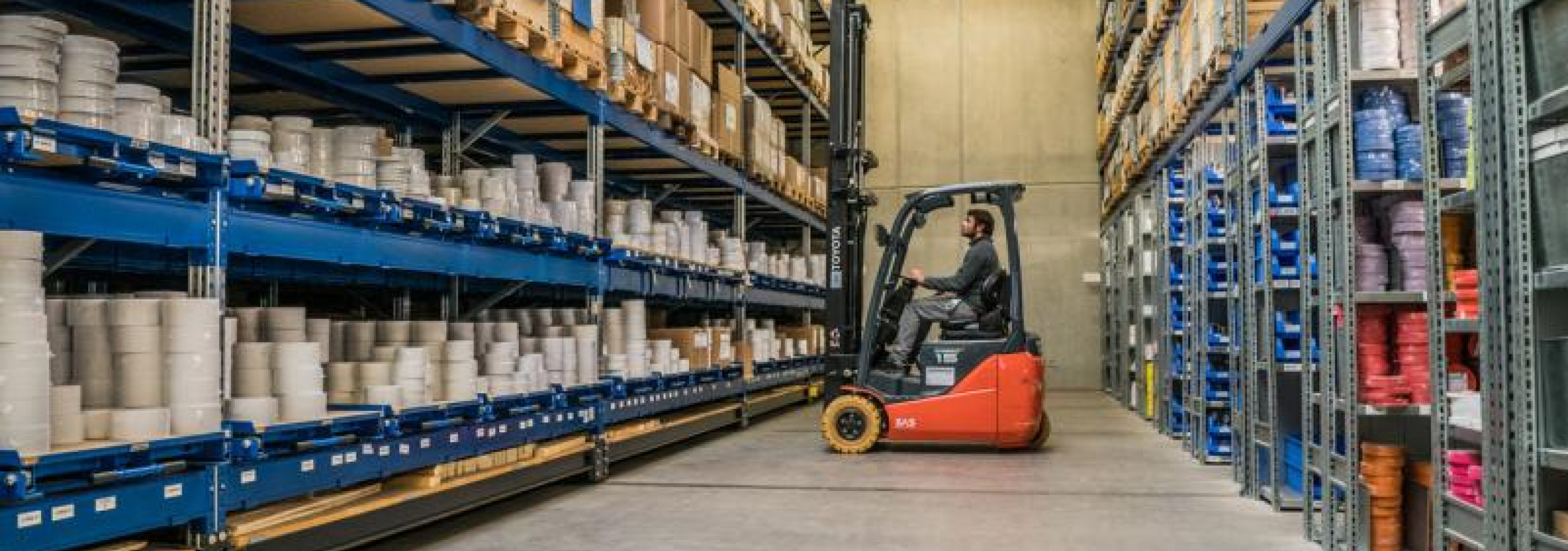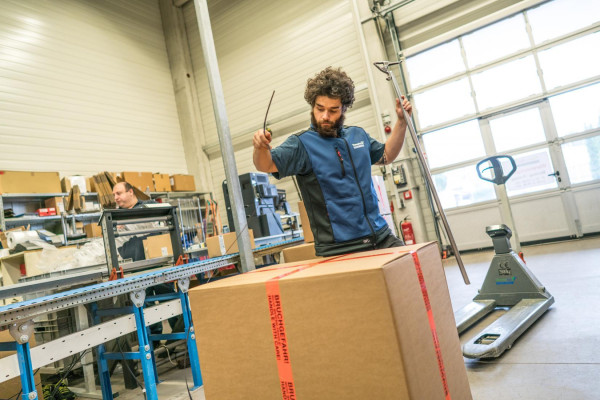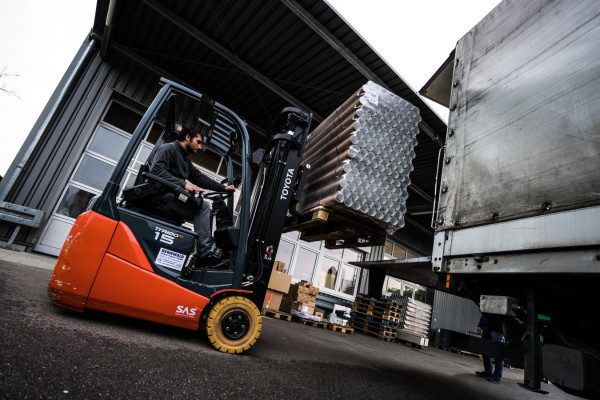

rotective googles and a mask cover the face of Sven Schena. Gloves protect his hands and a long-sleeved, splash-covered overall his clothes. The expert for warehouse logistics stands in a somewhat secluded area of the THERMOTEX dispatch department in Schutterwald and pulls a roll of pink plastic fi lm towards him. He cuts off a generous piece. Then he lines a large box with the fi lm and grabs hold of the nozzle of the foamer machine.
Machines, softly padded
At its opening, two chemical substances strike up an expansive relationship as soon as the trigger is pulled. The fl uid which Schena shoots out into the tub formed by the fi lm turns bit by bit into a voluminous foam padding. Once he has the bottom third of the box foamed, he pulls the overhanging fi lm over the mountain of foam, which is still expanding, thus forming a cushion. It’s intended for a Twinymat. After a while, when the foam has stopped expanding, Schena moves on to the next step: The 35 kilogramme heat sealing machine is laid gently and in the centre of the two-component cushion. It immediately sinks in a little and forms completely tailor-made transport protection. Another sheet of pink fi lm comes over the top of this and is turned into another cushion with the foam. But before the material can expand over the top of the box, Schena closes the top and attaches the package to its own pallet. Finally, the pocket with the delivery papers is stuck on and the pallet is driven over in the direction of the hall entrance. The specialist employee sends 10 to 15 machines off on their way like this - every day. “But it can sometimes be 20”, says Michael Eckert. The 26-year-old warehouse logistics master has headed the goods delivery/ warehouse and dispatch department at THERMOTEX for two years. In the three divisions, nine employees - including himself - ensure that customers all around the world are supplied accurately and on time with everything that THERMOTEX has to offer. The most noticeable are of course the pallets with the boxes, in which the machines such as the pneumatic heat sealing Twinymat as well as its smaller colleagues such as the Economy or the P-3 Futura are made ready for dispatch. But these make up only a small proportion of the total volume. “In addition to the pallets, we have around 160 packages each day”, calculated Michael Eckert. Achim Fischer is busy putting together one such packet at his workspace just now. The 42-year-old has been part of the THERMOTEX team since 1994. “When I started back then, generally speaking, everybody did everything”, he remembers with a smile, reaches to the side and routinely packs several rolls of CT2006 labels for thermal transfer printing systems for name labels into the box. “It doesn’t compare to today”, says Achim Fischer, who has already worked in production and in the workshop. While he seals the package, a delivery drives past outside: Replenishment for the high-bay shelves on the wall opposite the doors to the yard. “We have a total of 1200 pallet places here. Goods to the value of 3.5 million euro are constantly in the warehouse. We call it our high-bay store even if it doesn’t quite match the description”, says Michael Eckert. Industrial shelving is officially a high-bay store when it is more than 12 metres high. “Ours is only 5.5 metres high, so it’s missing a few metres”, says Eckert and laughs. On the other hand, that has the advantage that it can be completely managed with fork-lifts. A further advantage: The shelving units can be repositioned to make optimal use of the space. Michael Eckert swings into the seat of a fork-lift, presses the small, black switch on the windscreen and drives off. The button opens the hall doors, which buzzes open and closes again behind him. Three pallets with empty tubes are delivered. At least that’s what it looks like. In reality, these are roll cores that stand at the end of the production chain at THERMOTEX and form the core of a label roll when cut. “Something like what’s left over from a roll of kitchen paper, for example.” Two pallets are destined for Factory 1 and one palette goes to Factory 2. Linear distance: barely 200 metres. Materials that are incorporated directly into the production process don’t have to go via the big store. For one thing, this is better for the production processes and, for another, the little high-bay store is reaching its limits. “There are already considerations to create further storage space”, says Michael Eckert.
From Schutterwald to the entire world
Less than ten minutes later, Eckert has unloaded the pallets, finalised the formalities with the delivery driver and shown him the way to the second THERMOTEX address. “You can’t miss it”, he calls, waves goodbye and rolls towards the doors again on his fork-lift. In the sliding-shelf store, he rearranges three boxes so that this area of the warehouse can get fresh supplies from which Achim Fischer and his colleagues fill the customer packages. Michael Eckert parks the fork-lift in its place. “From here in Schutterwald, we send out our entire portfolio to all customers”, he says and makes a dispatching gesture with his hands. Countless printed and unprinted rolls for marking textiles sit beside small, unassuming-looking buttons, all of which bear the THERMOTEX logo: transponders. “The demand for the automatic identification of clothing is growing”, the warehouse logistics master has established. The little HF transponders are being ordered more and more and are packed into jars ready for dispatch. Most deliveries put together by Michael Eckert and his team are destined for Germany, followed by Austria and Switzerland, then France and the rest of the world. Now and again, however, Eckert registers a destination that is so rare that it piques his curiosity. “Recently, a delivery was shipped out to new Caledonia”, he reports, shrugging a little and smiling. A bit of research on the internet showed him and his team the journey that this package had in front of it: its destination is to a French island group in the South Pacific, about 1500 kilometres from the Australian north coast. Eckert and his team don’t have to worry about the papers or any customs information and such. They work to ensure that the right product arrives punctually and safely packaged at the right destination. When the carrier comes once a day to collect everything, all is sitting ready to go. “We generally dispatch within two working days”, says Eckert. “Irrespective of whether it’s a 35 kg Twinymat or two jars of HF transponders, or if the recipient is waiting in Nuremberg or New Caledonia.”